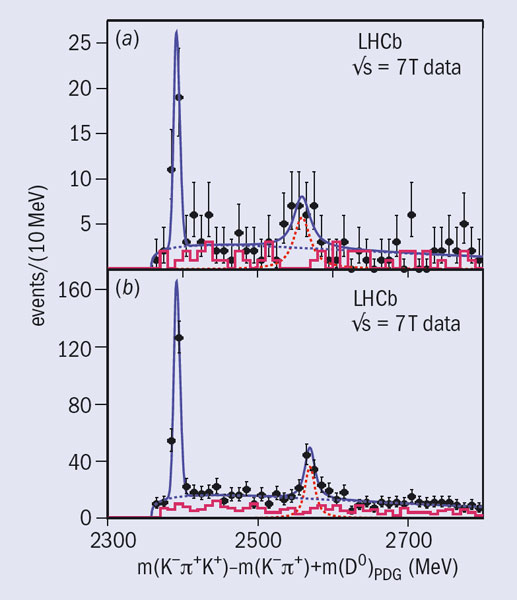
Using data collected in proton–proton collisions at the LHC at a centre-of-mass energy of 7 TeV, the LHCb experiment has observed new rare decay modes of B0s mesons for the first time. The decay B0s → J/ψ f0(980) will be important for studying CP violation in the B0s system, while the semileptonic decay B0s → D*–s2Xμ+ν will be valuable for testing QCD-based theoretical predictions.
The first new decay mode observed is of the hadronic decay B0s → J/ψ f0(980). This is particularly interesting because it is to a CP eigenstate, which means that it can be used in measuring mixing-induced CP violation. The B0s consists of a b antiquark (b) bound with an s quark, and can decay to a J/ψ (cc) together with an ss state, which can be a φ or, more rarely, an f0. While the φ decays to K+K–, the f0 decays to π+π–. The collaboration analysed J/ψK+K– and J/ψπ+π– events to search for the relevant decay candidates. Finally, using a fit to the π+π– mass spectrum with two interfering f0 resonances (f0(980) and f0(1370)), they measured a ratio of the B0s decays to J/ψ f0(980) and J/ψ φ of 0.252+0.046-0.032(stat.)+0.027-0.033 (syst.) (LHCb collaboration 2011a). The events close to the f0(980) could be used to measure the CP-violating phase for B0s decays, which is some 20 times smaller than in B0 mixing and hence much more sensitive to physics beyond the Standard Model.

The LHCb collaboration has also made the first observation of another decay, B0s → D*–s2Xμ+ν. The most frequent decays of the B0s involve the b quark changing into a c quark, resulting in a cs charm hadron, such as a D–s or D*–s , or other excited states. The relative proportion of such final states provides valuable information for testing theoretical models based on QCD. To investigate decays of this kind, the collaboration looked for final states in which the decay D0 → K+π– formed a vertex with a K– and a μ+. The analysis revealed two structures in the D0 K– mass spectrum at masses consistent with the Ds1(2536)– and D*s2(2573)– mesons (LHCb collaboration 2011b). While the Ds1(2536)– has been observed previously in B0s decays by the DØ collaboration at Fermilab’s Tevatron, LHCb’s result marks the first observation of the D*s2(2573)– state in B0s decays. The measured branching fraction relative to the total B0s semileptonic rate for the D*s2(2573)– comes out at 3.3±1.0(stat.)±0.4(syst.)%, while the value for the Ds1(2536)– is measured to be 5.4±1.2 ±0.5 %. These values agree well the prediction of the updated Isgur-Scora-Grinstein-Wise quark model, ISGW2.
The observation of these two new decay modes demonstrates that the LHCb experiment is already competitive in the field of heavy flavour physics. Great progress is expected with the larger data sample due from the coming run, with the potential to constrain, or even observe, new physics.
Further reading
LHCb collaboration 2011a arXiv:1102.0206 [hep-ex].
LHCb collaboration 2011b arXiv:1102.0348 [hep-ex].





